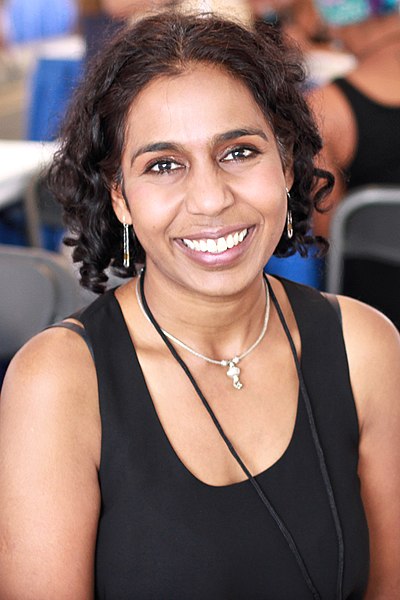Mills welcomed writer Shobha Rao for the Contemporary Writers Series on March 19.
Rao shared passages from her book, “Girls Burn Brighter,” and answered a multitude of engaging questions about her craft and process.

“An Unrestored Woman” and her novel “Girls Burn Brighter.”
Rao wrote the entirety of “Girls Burn Brighter” while she was staying in the isolated Badlands of South Dakota. She described the two months of writing in vivid detail, mentioning the juxtaposition between the extreme silence and terrifying storms that she encountered in South Dakota. The fear she felt during the storms helped her write the terror that exists within the story.
By writing the story of two girls facing terrible odds, she got to intimately know her characters and felt more personally courageous in the process.
“If I was going to have any company [in the Badlands], I would have to write them,” Rao said. “So I just sat there and made two friends and we traveled for two months together.”
She answered questions about the background of the novel and the importance behind it. For two and a half years, she worked at a domestic violence organization in the South Bay and encountered countless women who had endured incredible amounts of pain and violence. Rao explained how she was unable to comprehend the amount of resilience and strength these women had, and how they still were warm and friendly and had a light in their eyes.
Rao’s meditation through writing the story revolved around the assignment of value to a person’s experience, such as their journey or their sorrow. What is one’s journey worth?
She insightfully spoke about the weight of boundaries through a geopolitical lens that has characterized many political issues─country boundaries, such as the partition of India and Pakistan, and the boundaries of a woman’s body. She stated that the body is women’s true boundary and how it is constantly bartered and negotiated.
Violence and human trafficking play prominent roles in “Girls Burn Brighter,” and Rao believes this is an important facet to her writing.
In particular, the 1999 case in Berkeley about a man who was arrested for sex trafficking haunted Rao, especially with the close proximity to where she lived. She said that she would only stop writing about human trafficking until it doesn’t exist.
“I will write a lot, if not forever, about [violence],” she said.
Attendees asked during the event about the intricacies of her craft. Such as, when asked what she believes a novel needs, she stated three things─what does the character want? What happens if they don’t get it? And, interestingly, she said that she needs to know the ending of her story before she writes it.
Rao spoke more about character development, stressing the importance of finding formative events in their lives that can define their experiences. She recalled a personal narrative of falling off an edge as a child and severely injuring herself; when her parents brought her to the doctor, she started crying because she saw a banana and wanted to eat, not because of the pain.
She linked this to hunger and motivation in character development, and how impressionable events such as those show a greater depth of what someone wants, even if it’s not necessarily obvious. She talked about the characters’ multifaceted hunger in “Girls Burn Brighter” and how to highlight this within their stories.
“The more obscure their knowledge of their motivations are, the more interesting it can be,” she said.
Rao’s passionate descriptions of the writing process was contagious throughout the event. She discussed the atmosphere of writing and the connection to the reader.
“Any piece of writing is the creation of an atmosphere,” she said. “So you’re creating kind of a cocoon the reader is going to travel in throughout the book, and I think the more rich and beautiful you can make that cocoon, the more invested the reader will be in your work.”
She described having a reader stay invested in the book as a delectable and ethereal experience, and how a writer shows an extension of their deeper self to the reader and offers without hesitation.
The latter half of the event sparked intriguing and detailed answers from Rao, who talked more about suffering and joy in the world.
In a sense, she found the suffering in the book cathartic, because it allowed her to let go of all the emotions she was holding onto. She said it was necessary and an integral part of the novel-writing process to acknowledge that everyone has the capacity for doing terrible things.
“It is not a shameful thing, but a necessary thing,” she said. “Then you can proceed knowing the capacity for our own violence and our own despair and our own hope, our own light. I think about the extremes in my work.”
When asked about what brings her joy, Rao shared her day of traveling to Mills and taking time to look around, enjoying the little things─most notably encountering one of the beloved cats on campus, who she particularly enjoyed a lot. In the end, however, she stressed the overall pricelessness of joy.
“We have to cultivate joy because no one is going to hand it to us,” she said. “It is a thing that must insist upon our lives and we find it, and I’ll be damned if it costs any money. I will never hand over money for joy. I find it in the natural world.”
